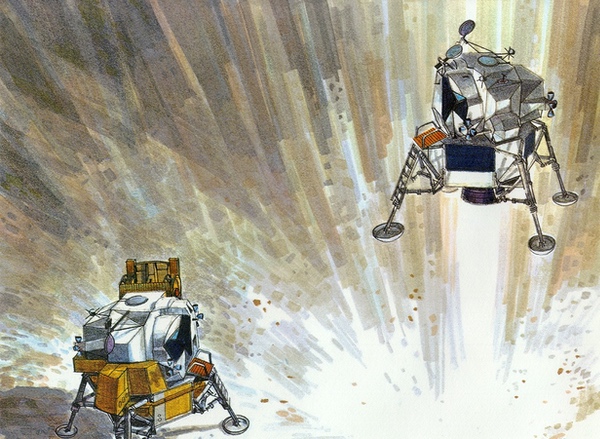Apollo 21: Upgrading the Lunar Module for advanced missionsby Dwayne A. Day and Glen E. Swanson
|
| Grumman proposed ways to expand several constraints on Apollo missions, based upon the assumption that NASA would also make modest improvements to the Saturn V, and be capable of pursuing dual launch missions. |
Grumman Aerospace sought to develop its basic Lunar Module into a vehicle that could do more than simply land two astronauts on the Moon for short periods. The company claimed that the Lunar Module (LM) was a versatile vehicle capable of flying with astronauts or robotically, and possessed substantial propulsive capability and internal volume that would be useful for other missions. Grumman proposed a variety of Lunar Module-derived vehicles for use in Earth or lunar orbit, and on the lunar surface. Grumman engineers claimed that missions of two months duration in Earth orbit and at least two weeks duration on the Moon could be conducted using Lunar Module derivatives. They argued that experience obtained on early LM missions would reduce cost while greatly increasing mission and scientific objectives. Grumman prepared a heavily illustrated briefing for NASA proposing alternative missions for the LM. Although the exact date of the proposal is unknown, it was probably made in 1968 or early 1969.
Advanced lunar exploration
Apollo landings were constrained in multiple ways, including the areas of the lunar surface that could be reached as well as the mass that could be landed and the duration the astronauts could spend on the lunar surface. Grumman proposed ways to expand several of these parameters, based upon the assumption that NASA would also make modest improvements to the Saturn V, and be capable of pursuing dual launch missions.
Apollo Lunar Module
The Apollo LM consisted of a descent stage and an ascent stage. The Lunar Modules for the first several missions—Apollos 11 to 14—were essentially the same, and had limited capability in terms of mass and duration on the surface. The descent stage carried the expendables used during the descent to the Moon and the exploration equipment. This included the engine, propellant, the landing gear, and the Apollo Lunar Scientific Experiment Package (ALSEP). The ascent stage contained the crew’s life support equipment and expendables and most of the spacecraft’s other operating subsystems. The ascent stage included the engine and propellants used to return the astronauts to the Command Service Module (CSM), and storage provisions to return scientific samples.
As designed, the Lunar Module could sustain the astronauts for 48 hours away from the CSM, carry a 136-kilogram (300-pound) scientific payload to the Moon, and transport 45 kilograms (100 pounds) of payload on its return trip to the CSM. But Grumman’s engineers were actively seeking ways to expand the LM’s capabilities for future missions, both in the near and mid-term.
Extended LM
For single-launch missions, experience gained from the initial Apollo LM lunar landings could permit an increase in LM payload with no increase in the size or capacity of the descent tanks. The added payload could extend the astronauts’ time on the Moon to three days and provide them with up to 318 kilograms (700 pounds) of scientific equipment, including Lunar Flying Vehicles (LFVs) or a small Lunar Roving Vehicle (LRV). The Extended LM was the only proposed LM upgrade that was actually built. Starting with Apollo 15, the LM was modified to carry more mass and operate on the surface a bit longer than the first missions. Notably, Apollo 15 carried the Lunar Roving Vehicle, which was cleverly installed folded up in a compartment on the side of the LM’s landing stage.
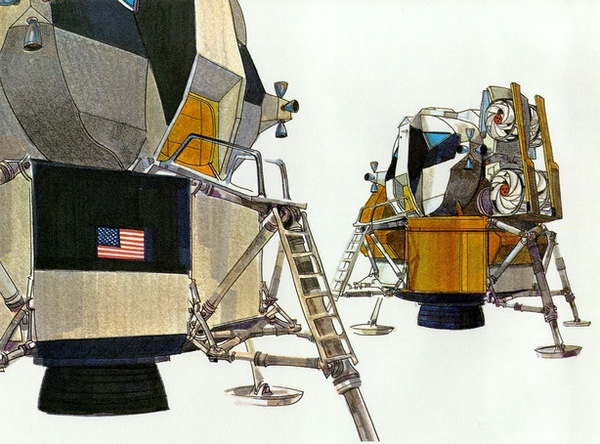 Grumman proposed various LM upgrades, including dual-launch missions that would have included a robotically landed LM and a piloted Taxi vehicle. Here the Taxi is in the foreground. Although similar to the standard LM actually flown, it would have been equipped with window shades and a hatch cover to keep the vehicle from getting too cold. It also would have been equipped with radioisotope heating units, vehicle health monitoring systems, and a radioisotope thermoelectric generator to power the batteries. The background vehicle may be a Lunar Base Module, which would maximize internal volume and serve as an astronaut habitat for up to 14 days. |
LM Taxi
Outwardly identical to the Apollo LM, the LM Taxi differed from its parent spacecraft by a few subtle modifications necessitated by the slightly different nature of its mission. The LM Taxi mission was to ferry two astronauts to the Moon on the second leg of a dual launch following the successful landing of a logistics vehicle (Truck or Shelter) on the first leg. The Taxi would have carried the same life support provisions as the Apollo LM. The astronauts would shut down and store the Taxi after landing, and transfer quarters to the logistics vehicle for the 14-day stay. However, if the astronauts found the logistics vehicle unsatisfactory for habitation, a contingency mission could be performed by having the astronauts return to the Taxi and live there for the duration of the mission.
Because the Taxi was designed to stay dormant while the astronauts were in a Shelter vehicle, it would have to be modified for those conditions. The internal equipment would have to be thermally controlled to enable rapid abort. This would include a hatch cover, window shades, and isotopic heating sources. It would also be equipped with monitoring equipment so its condition could be assessed. The battery power system would be supplemented by a radioisotope thermoelectric generator.
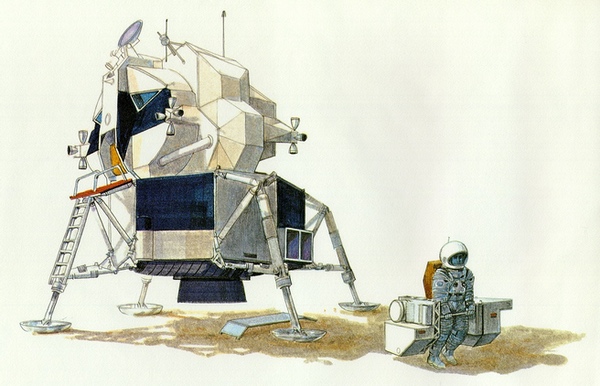 The Augmented LM would have increased stay times on the lunar surface. It could have operated in either a single launch mode like the later Apollo missions, or a dual-launch mode, where it would have carried cargo and supplies for astronauts landing in an LM Taxi. |
Augmented LM
Increases in the Saturn V payload capacity through normal up-rating, such as adopting the F-1A engines for the Saturn V rocket (see “A mighty thunderous silence: The Saturn F-1 engine after Apollo,” The Space Review, June 3, 2019) could permit increases in the allowable LM separation weight and lunar landed payload. An Apollo LM, augmented by increased descent propellants, and hence more burn time, would have significantly benefited from this increase in payload capability. For single-launch missions, the additional LM capacity could be used for payloads that enabled longer stay times and more scientific experiments. For example, more than 900 kilograms (2,000 pounds) of scientific payload could be carried with the same one-and-a-half day stay time as the Apollo LM. If longer stay times were desired, more than 450 kilograms (1,000 pounds) of scientific payload could be landed with provisions for an eight-day stay. In dual-launch missions, the scientific payload would be landed by a logistics vehicle and the Augmented LM would then carry more expendables.
For dual-launch missions, the astronauts would first unload the expendable supply modules from the logistics vehicle and transport them the short distance to the Taxi using a lunar rover off-loaded from the logistics vehicle. Umbilicals from the modules would connect to an external panel on the Taxi, transfusing life-support fluids to the spacecraft and enabling the astronauts to perform the alternate missions. If the logistics vehicle did not include living quarters, this cargo transfer and Taxi activation would be the normal procedure for a 14-day mission. The Taxi’s return mission profile would have been a duplicate of the Apollo LM. However, the ascent payload could be increased in two ways: either by topping off the ascent tanks prior to Earth launch or by reducing the lunar ascent propulsion budget.
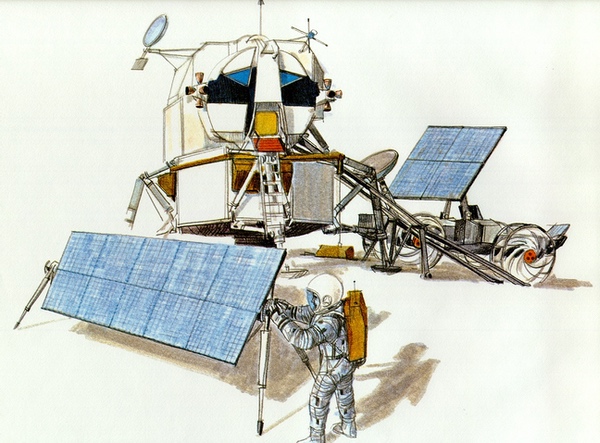 The Shelter LM would have landed robotically as part of a dual-launch mission. It would have been visited by astronauts landing in a Taxi, and had systems to support a stay of up to 14 days on the lunar surface. |
LM Shelter
The Shelter was an Apollo LM minus its ascent propulsion system modified to make a larger volume. It would be able to stay dormant on the Moon as long as 60 days, and then support two astronauts for 14 days after they landed in a Taxi spacecraft. Without the ascent engine, there would be more habitable volume for the crew, who would have special hammocks. The Shelter would also have an airlock attached to the forward hatch, eliminating the need to depressurize the cabin before lunar surface egress.
| Grumman was also studying several versions of flying and roving vehicles to support advanced lunar surface scientific exploration. |
A Shelter launch and successful landing would be followed by a crewed Taxi in a dual-launch mission. Shelter payload could consist of expendables, mobility aids, a 30-meter lunar drill, and an advanced Apollo Lunar Surface Experiment Package. Normally, the expendable packages carried by the Shelter would be used to support the astronauts within the spacecraft. However, if the Shelter became inoperative for any reason, the astronauts could resort to a backup mode by removing the packages, carting them to the Taxi, and plugging them into mating fittings on that spacecraft. The Taxi would then become home to the astronauts with a minimum of disruption to the mission.
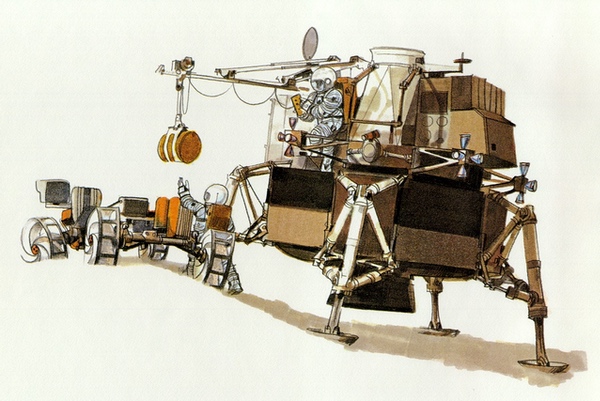 The first Truck vehicle proposed by Grumman would have preserved some ascent vehicle systems in a central trunk mounted to the descent vehicle. This would be accessed by an astronaut in lunar orbit who would have updated the vehicle's flight computer prior to descent in order to increase landing accuracy. The LM Truck could have carried a crane for lowering equipment to the surface. |
LM Truck
The LM Truck was an unmanned lunar lander that transported cargo in the volume provided by a converted ascent stage. A Truck landing represented only half of a dual-launch mission. Once the payload arrived successfully on the Moon, a second Earth launch of a Taxi would dispatch astronauts who would use the life-support and scientific equipment on the Truck in performing their duties during long-duration lunar explorations. A typical mission profile might consist of a Lunar Module uncrewed landing on the Moon, remaining dormant for up to 60 days, and then supporting two astronauts for 14 days.
Components from the removed ascent stage that were still vital to the Truck mission would be relocated to a central docking structure attached to the existing interstage fittings on an unmodified descent stage. The docking structure enabled the Command and Service Module to transpose and dock to the Truck in lunar orbit and extract the Truck from the Spacecraft LM Adapter (SLA). After docking, an astronaut from the CSM could reach into the structure through the docking tunnel and use a keyboard stored in the structure to update the Truck’s Guidance, Navigation and Control Subsystem so that the spacecraft’s trajectory to landing was held within acceptable tolerances.
A typical Truck mission might carry a Roving Vehicle for surface transportation, resupply modules for supporting two astronauts in the Taxi up to 14 days, and a 1,678-kilogram (3,700-pound), 11.3-cubic-meter (400-cubic-foot) scientific payload.
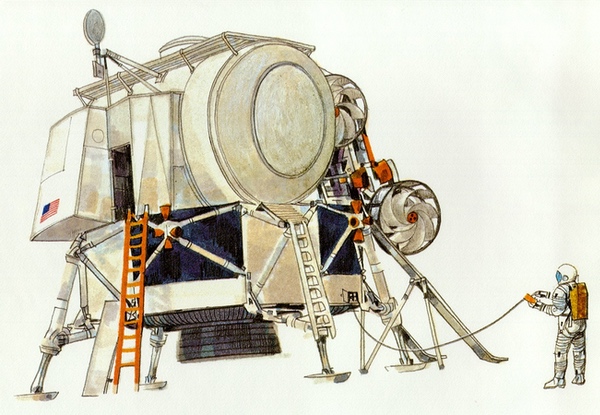 The second Truck vehicle proposed by Grumman would have moved all equipment needed for the descent into the descent stage, freeing up space on top of the stage for more cargo. Note that the reaction control thrusters have been moved to the descent stage. |
LM Truck-2
This alternate LM Truck moved all ascent stage components needed for the robotic landing into the descent stage. The reaction control thrusters would be mounted to the descent stage, effectively creating a flat platform above the descent stage for the carrying of large cargo. The vacated ascent stage volume, 46.7 cubic meters (1,650 cubic feet) could be filled with 4,000 kilograms (8,800 pounds) of payload. The representative payload consisted of a 21.5-cubic-meter (760-cubic-foot) fixed crew living quarters, Lunar Roving Vehicle, crew provisions for up to 14 days, and a 900-kilogram (2,000-pound), 13.9-cubic-meter (490-cubic-foot) scientific cargo.
Lunar Base Module
The Lunar Base Module would have a similar mission as the Shelter, landing robotically and then visited by astronauts landing in a Taxi. The ascent stage would not have a propulsion system and would be enlarged. The midsection diameter would be enlarged and the rear bulkhead moved back. This would provide sufficient internal volume for two beds, instead of hammocks. A radiator would replace the environmental control system water sublimator, and power would be provided by solar panels. Like the shelter, it could remain dormant on the Moon for 60 days and support two astronauts for 14 days.
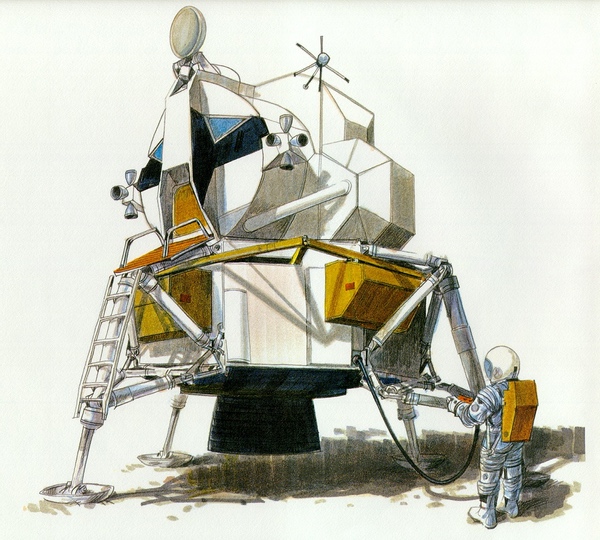 This artwork appears to show the Lunar Payload Module, which represented a relatively minimal modification of the basic LM, used as part of a dual-launch mission. |
Lunar Payload Module
Unlike the LM Truck, the Lunar Payload Module retained the basic LM ascent stage but would be stripped of the ascent propulsion system and any components not needed for a lunar landing. In this configuration, the existing ascent and descent stage structures could hold a 3,040-kilogram (6,700-pound) payload within a useful volume of about 21 cubic meters (730 cubic feet). Its mission would be like the other logistics vehicles launched at the start of a dual-spacecraft mission. The payload module would land robotically and make available provisions, expendables, and equipment to resupply the Taxi or replenish astronaut supplies. It represented a minimum modification version of the lander.
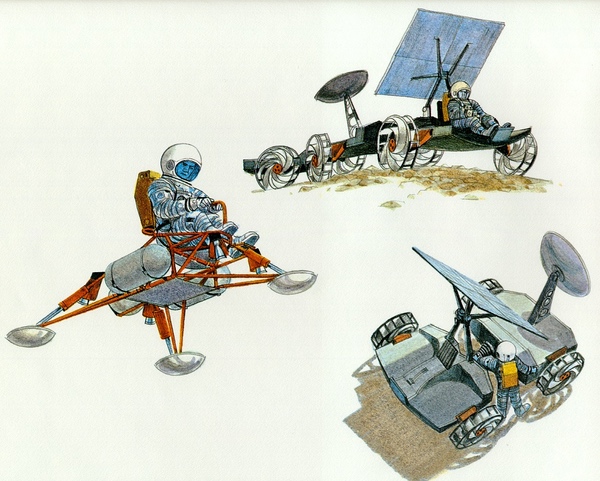 Grumman also suggested various vehicles for improving the mobility of astronauts on the surface, including small and medium rovers, as well as a flyer. Ultimately, Boeing built the Lunar Roving Vehicle carried on Apollos 15–17. |
Mobility aids
Grumman was also studying several versions of flying and roving vehicles to support advanced lunar surface scientific exploration. These included the Lunar Roving Vehicle, the Dual-Mode Lunar Roving Vehicle, and the Lunar Flying Vehicle. Apollos 15–17 eventually carried the battery-powered Lunar Roving Vehicle, built by Boeing, although larger pressurized rovers had also been studied by the late 1960s.
Lunar Roving Vehicle (LRV)
Capable of carrying 227 kilograms (500 pounds) including an astronaut, the medium-duty roving vehicle was also small enough to be carried on a single-launch mission. Although its radius of operation was limited to 3.7 kilometers (two nautical miles) by backpack communications restraints, its battery power would have permitted a 27.8-kilometer (15-nautical-mile) sortie before recharging. The vehicle would have weighed between 270–360 kilograms (600–800 pounds) and could be converted to remote control by adding appropriate equipment.
Dual-Mode Lunar Roving Vehicle (DLRV)
The largest vehicle studied by Grumman, the heavy-duty DLRV could also move 227 kilograms (500 pounds), but its radius was 14.8 kilometers (eight nautical miles) and it could traverse 46.3 kilometers (25 nautical miles) per sortie on a battery charge. This vehicle would have weighed 680 kilograms (1,500 pounds) and would be carried on a robotic logistics spacecraft such as the LM Shelter or Truck. Vehicle batteries could be recharged from the delivery spacecraft. The DLRV could be operated by remote control through an Earth-to-DLRV communications link.
Lunar Flying Vehicle (LFV)
This light duty vehicle could be carried on a single-launch mission. It would have carried 136 kilograms (300 pounds) of the same propellant used by the LM descent engine, which meant that the residual propellants in the LM could be transferred to the Lunar Flying Vehicle (LFV) after landing. In use, the LFV could hold one astronaut with about 168 kilograms (370 pounds) of scientific equipment, or two astronauts with no equipment on a rescue mission.
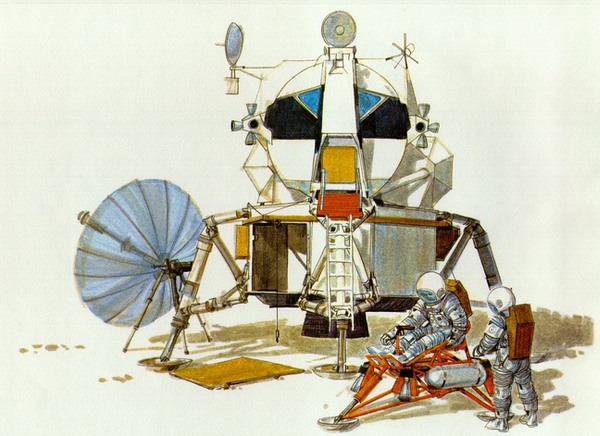 The Lunar Flying Vehicle could have used the same propellants as the Lunar Module. |
Flying Lunar Modules
Grumman also evaluated the LM ascent stage for several different free-flying missions where it would not land on the lunar surface but perform science or other tasks, either in Earth or lunar orbit. These included laboratory, solar and astronomy observatories, and a rescue spacecraft.
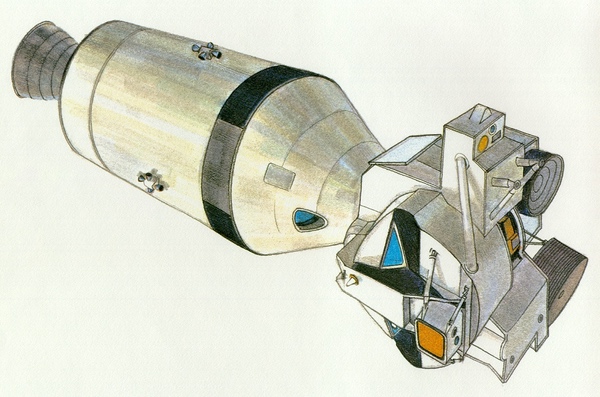 The Lunar Reconnaissance Module would have used an LM descent stage to place an Apollo Command Service Module and modified LM into polar orbit around the Moon. The descent stage would have then been jettisoned, and astronauts would have used instruments mounted to the LM ascent stage to take various measurements of the lunar surface and subsurface. |
Lunar Reconnaissance Module
Apollo missions were limited to a narrow band of landing sites around the lunar equator and the near side. The Lunar Reconnaissance Module would have been a polar-orbiting spacecraft carrying an extensive instrument suite consisting of photo-mapping, geochemical, and electromagnetic surveying equipment. It would remain docked to the CSM and would survey the surface, subsurface, and near-lunar environment.
| Heavily-equipped with experiment instrumentation, capable of operating in Earth or lunar orbit, and provisioned to sustain two astronauts for 45 days in space, the LM Laboratory was a radical proposal for the LM. |
The LRM would use the LM descent stage for lunar orbit insertion and would then be jettisoned. The ascent stage, without propulsion and reaction control subsystems, would carry the sensors. It would also be equipped with an electrical power supply system and thermal control system, as well as navigation and control equipment. The LRM would conduct a 14-day mission in lunar orbit, and all operations would be conducted from inside the spacecraft in a shirtsleeve environment.
LM Laboratory
Heavily-equipped with experiment instrumentation, capable of operating in Earth or lunar orbit, and provisioned to sustain two astronauts for 45 days in space, the LM Laboratory was a radical proposal for the LM. Its experiment sensors would have included radiometers, spectrometers, a stellar camera, a terrain camera, multispectral cameras, X-ray sensors, a day/night camera, and an infrared imager. These devices could have been used for meteorology, astronomy, Earth resources, lunar survey and mapping, bioscience, and engineering technology.
Stripped of ascent and descent propulsion systems and the landing gear, the laboratory still retained its docking compatibility with the CSM. It could have been launched by either the Saturn IB or Saturn V vehicle.
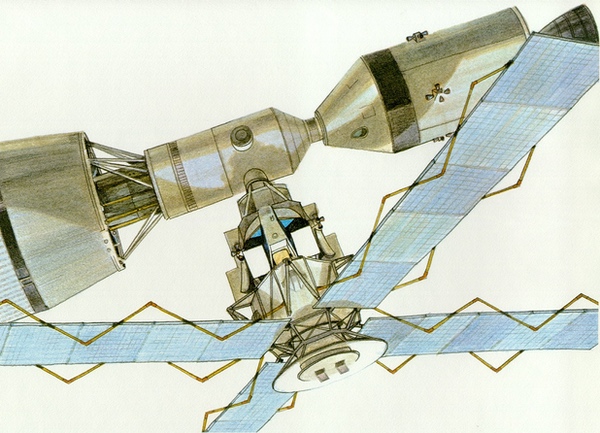 One possible modification of the LM ascent stage was to support solar instruments. NASA eventually developed the Apollo Telescope Mount for Skylab, but did not use the LM. |
LM/Apollo Telescope Mount
In this LM modification, the entire descent stage would have been replaced by the Apollo Telescope Mount (ATM) structure. Among the major items attached to the structure were solar astronomy experiment equipment, solar arrays, and control moment gyroscopes. Besides gathering data on the physical characteristics of the Sun, the spacecraft could be equipped to perform a robotic rendezvous and dock to an orbital assembly, and operate in orbit up to 51 days in an open-ended mode. The LM could also be modified to deliver orbital resupplies or other experiment modules.
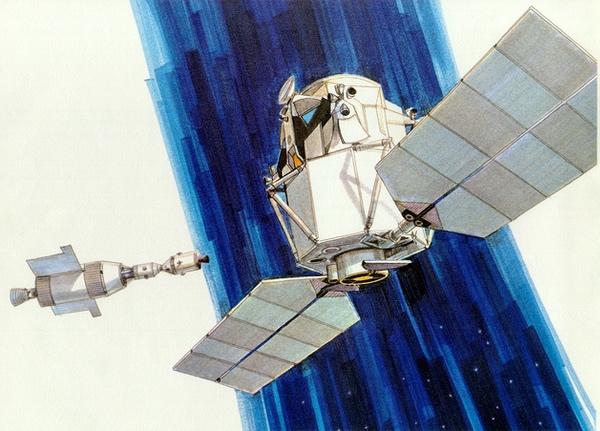 Another possible modification of the LM ascent stage was to equip it with an ultraviolet telescope. Grumman proposed that it could be a free flyer that separated from a larger spacecraft. |
LM/Stellar Apollo Telescope Mount
This was a version of the Apollo Telescope Mount with the solar telescope replaced with a large aperture stellar optical telescope. This Stellar ATM could then be used to collect scientific data on celestial objects in the ultraviolet spectrum. Such a configuration could be operated in a robotic or human-attended mode of operation.
The Stellar ATM could detach from the main orbital station to increase stabilization periods and higher pointing accuracy required for stellar targets. The solar array could be gimballed to permit orientation with the Sun independent of the line of sight of the experiment package.
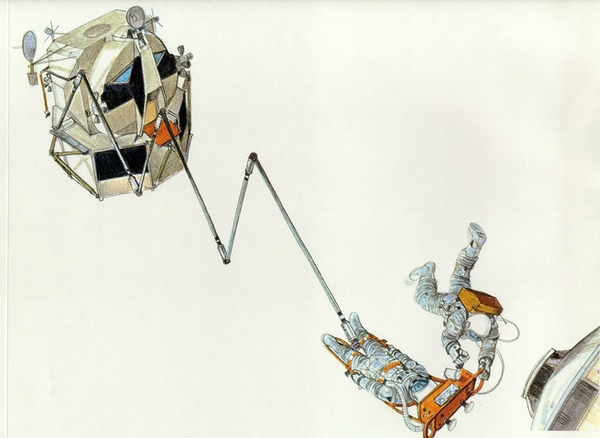 One proposed Grumman modification would have used the ascent stage as an inspection and rescue vehicle. |
Rescue LM
The LM’s two-stage main propulsion system, combined with the fully redundant reaction control system and versatile guidance and navigation capability, offered an in-orbit maneuvering manned vehicle of unique capability. The application of this capability by a LM with very limited modifications would permit in-orbit intercept of, and rendezvous with, other space vehicles for such purposes as personnel rescue, and spacecraft inspection or repair.
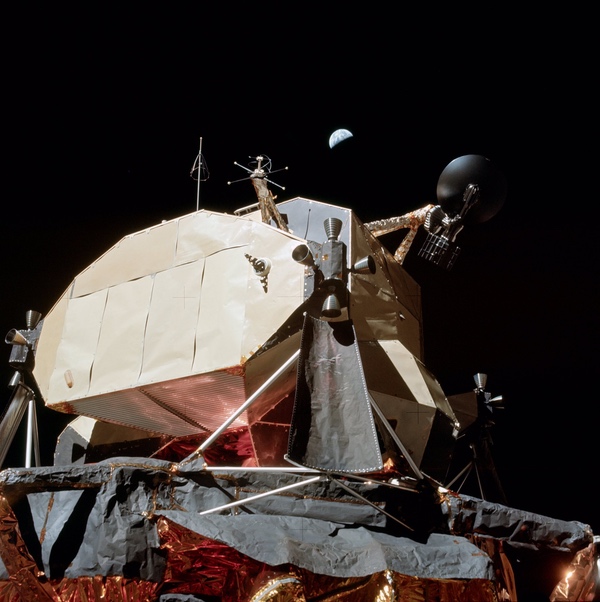 The Apollo 17 Lunar Module Challenger on the Moon's surface in December 1972. Many of Grumman's proposed upgrades to the LM would have enlarged the vehicle, including by moving this rear section, which contained avionics systems. Some versions were robotic landers that eliminated the propulsion system in the ascent stage to increase internal volume. (credit: NASA) |
Unrealized dreams
Most of the Grumman proposals reflected relatively straightforward derivatives of the basic LM vehicle which presumably could have been developed in only a few years—perhaps by the early 1970s. That does not mean they would have been inexpensive upgrades, but compared to other proposals, like large lunar cargo landers that were proposed in several 1969–70 lunar base studies, they would have been lower risk and lower cost.
| With Apollo coming rapidly to a close, the opportunities for expanding lunar exploration were gone. Grumman’s Lunar Module was a great performer, but its future dimmed before fading completely away. |
Key NASA officials were skeptical that a vehicle that had been specifically designed for such a narrow mission could be adapted to other uses. Certainly, the LM could have been adapted for other lunar missions, but Grumman’s engineers were stretching the limits of credibility to argue that the vehicle had potential in Earth orbit and for scientific missions.
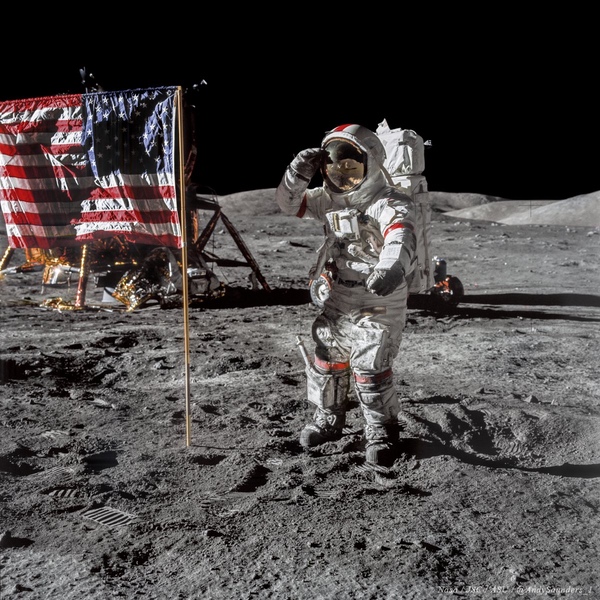 Astronaut Gene Cernan on the Moon. Apollos 15, 16 and 17 were almost canceled. Missions 18-20 were planned, and much hardware was built, but those missions were canceled to reduce costs and to avoid the risk of killing astronauts. (credit: NASA) |
But the primary reason NASA did not adopt these proposals was money. By the mid-1960s NASA’s budget was decreasing and the agency’s leadership had no reason to expect large budgets to fund ambitious goals once Apollo ended. The Apollo program was always focused upon beating the Soviet Union to the Moon. Once that goal was in sight, the American political leadership saw no further need to spend such enormous amounts of money on the space program. Apollos 18, 19, and 20 were canceled even though much of the hardware was already completed, and they would have used the existing, slightly upgraded LM design. By the time of the Nixon Administration, even Apollos 15–17 were in danger of cancellation and the latter two missions were only saved after Nixon was told that doing so would send a message to the world that America’s best days were past.
Flying Apollos 21 and beyond would have required restarting the Saturn V and Apollo production lines. The rocket and spacecraft had proven highly capable, and highly expensive. With Apollo coming rapidly to a close, the opportunities for expanding lunar exploration were gone. Grumman’s Lunar Module was a great performer, but its future dimmed before fading completely away.
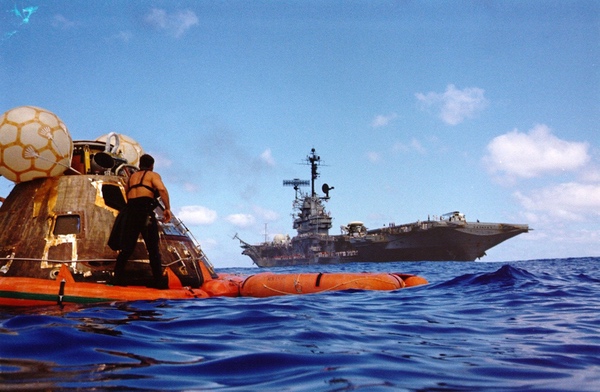 Apollo 17 splashed down in the Pacific Ocean on December 19, 1972. It was the last time that humans walked on the Moon. (credit: NASA) |
Note: we are using a new commenting system, which may require you to create a new account.
